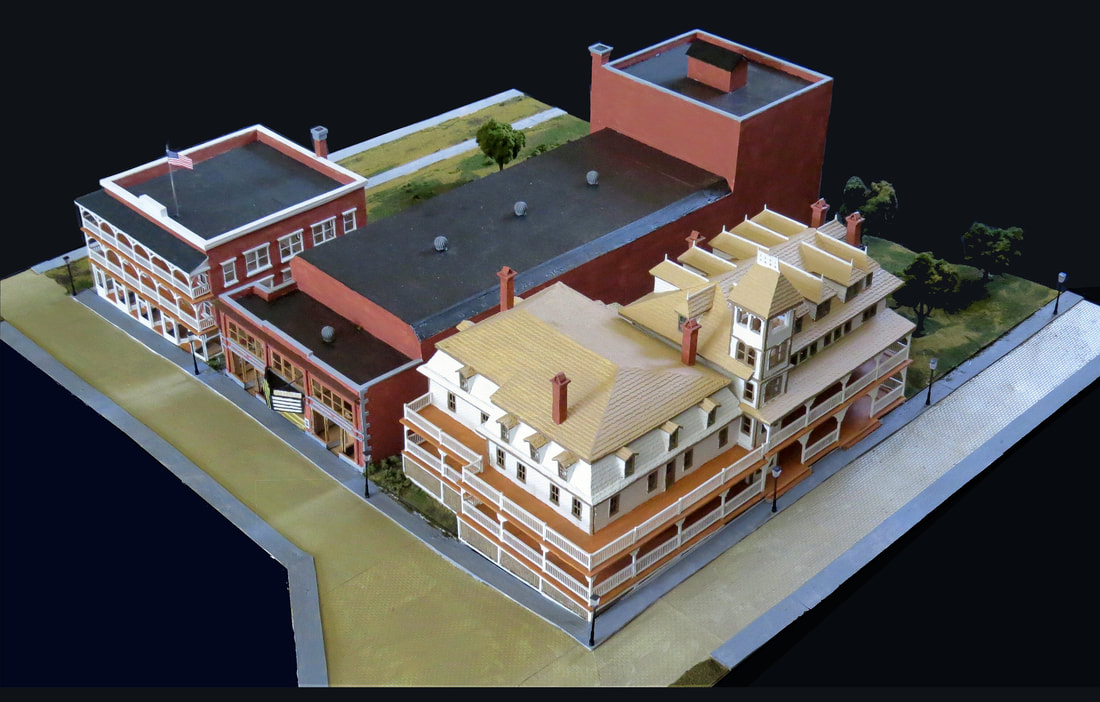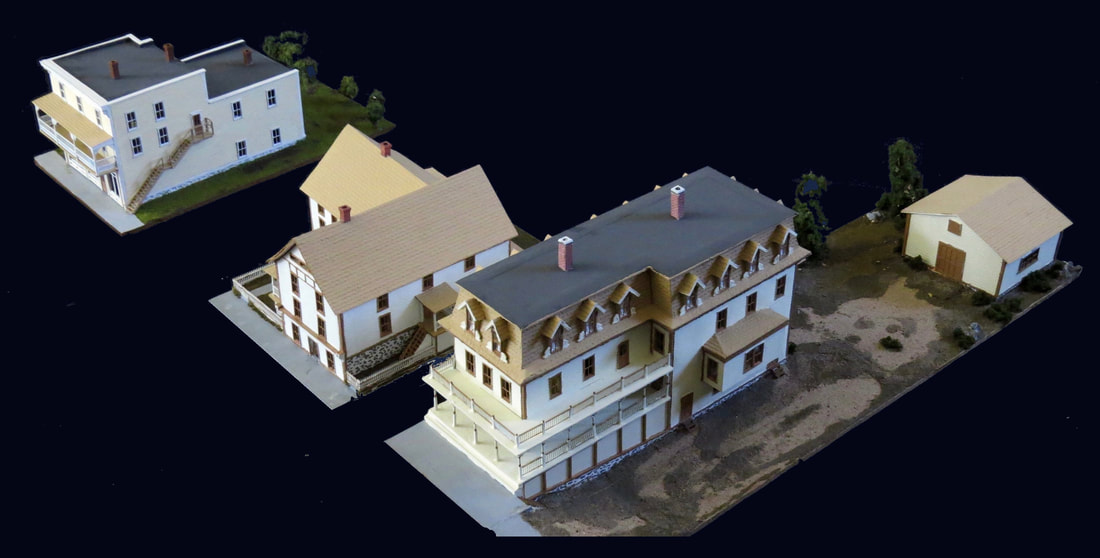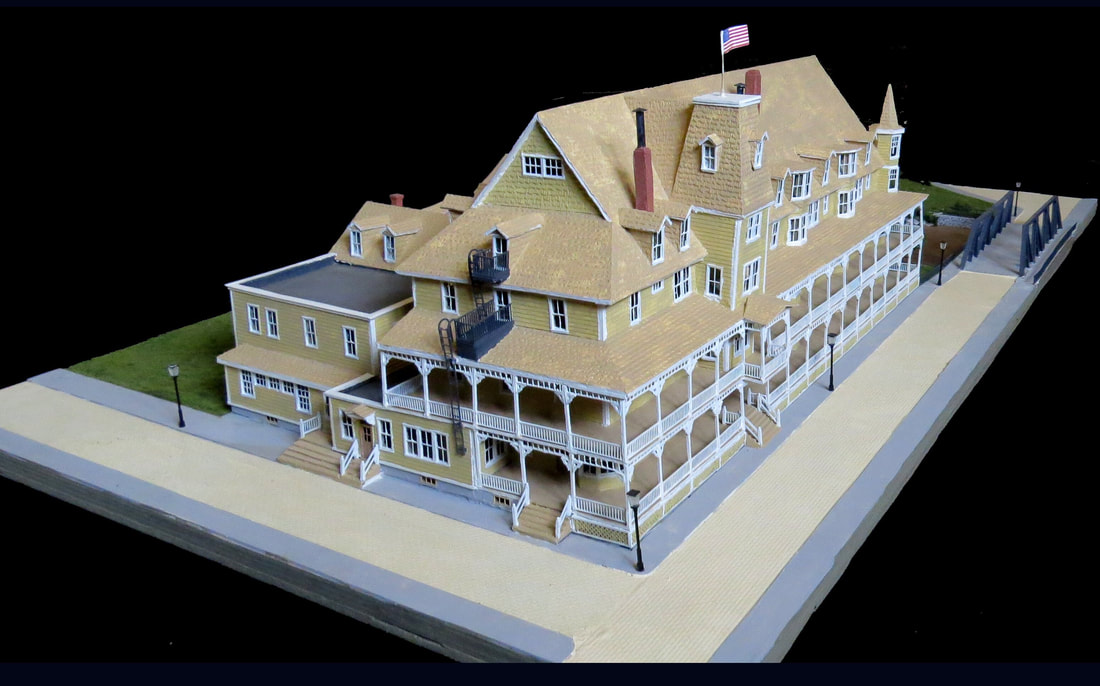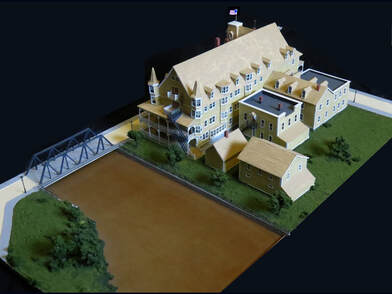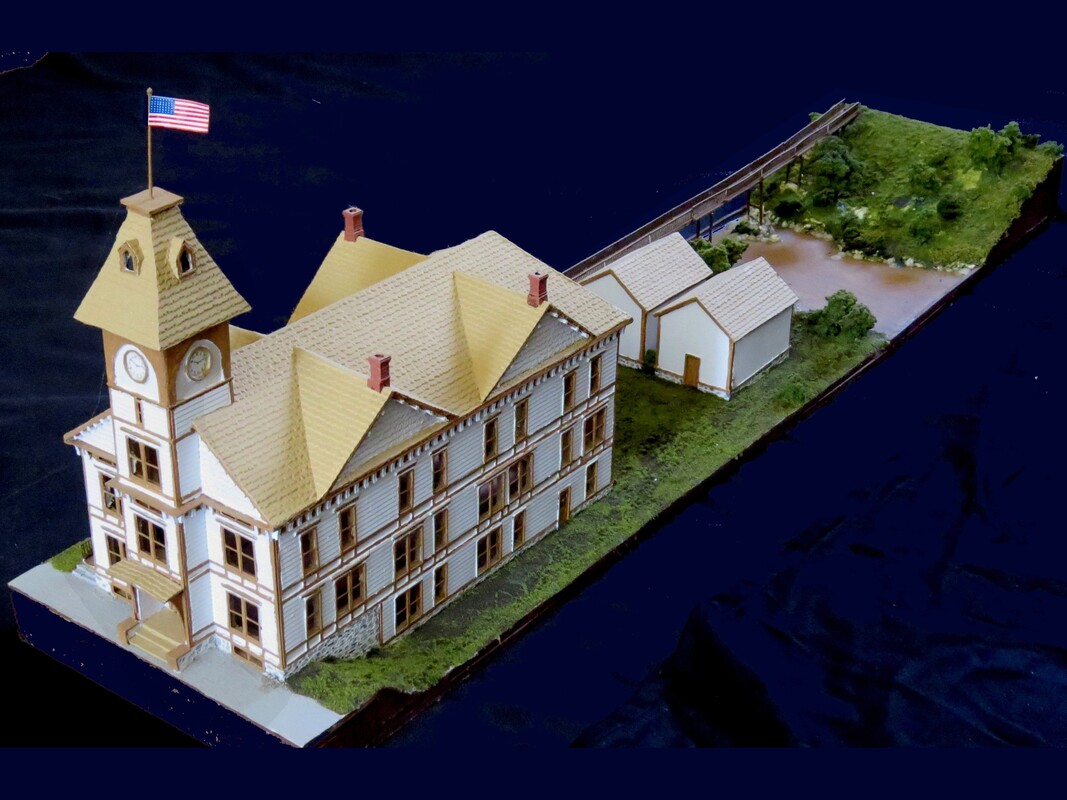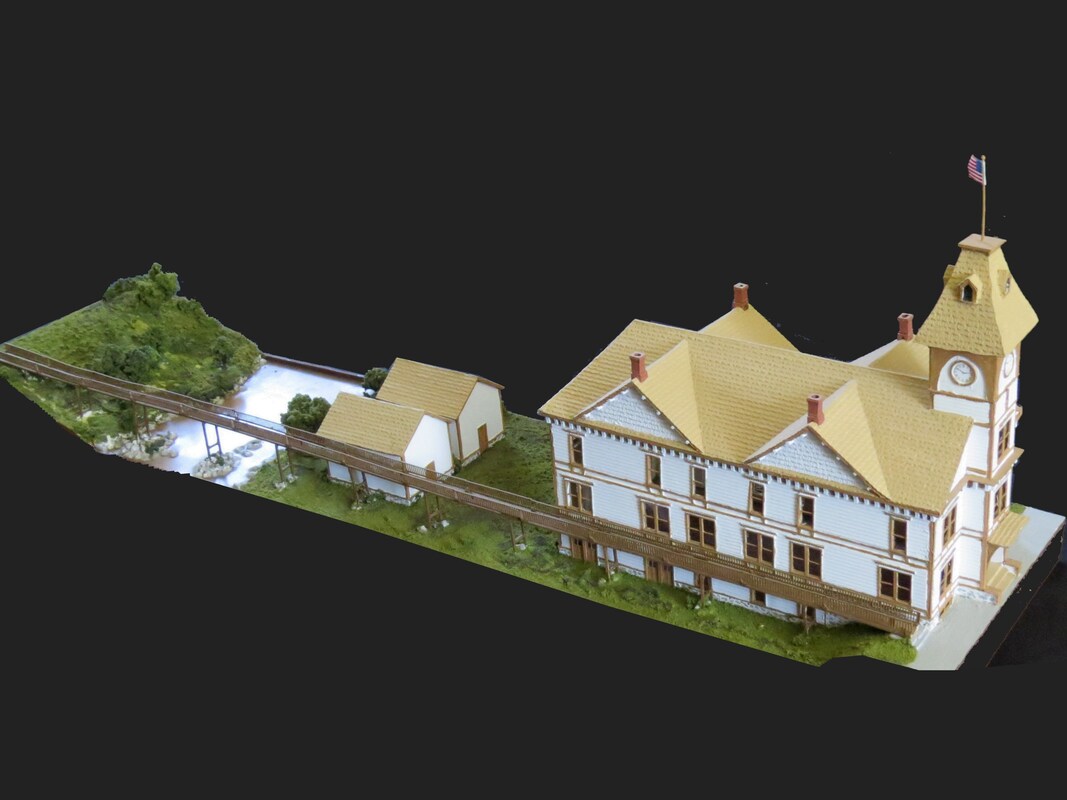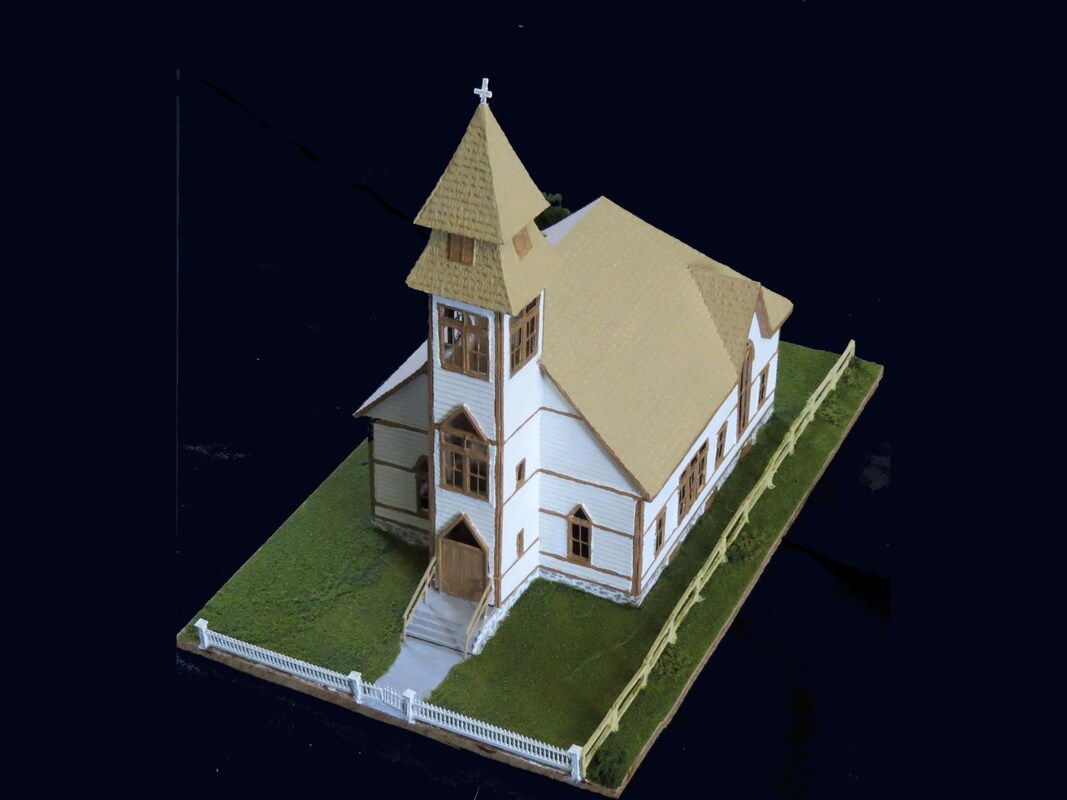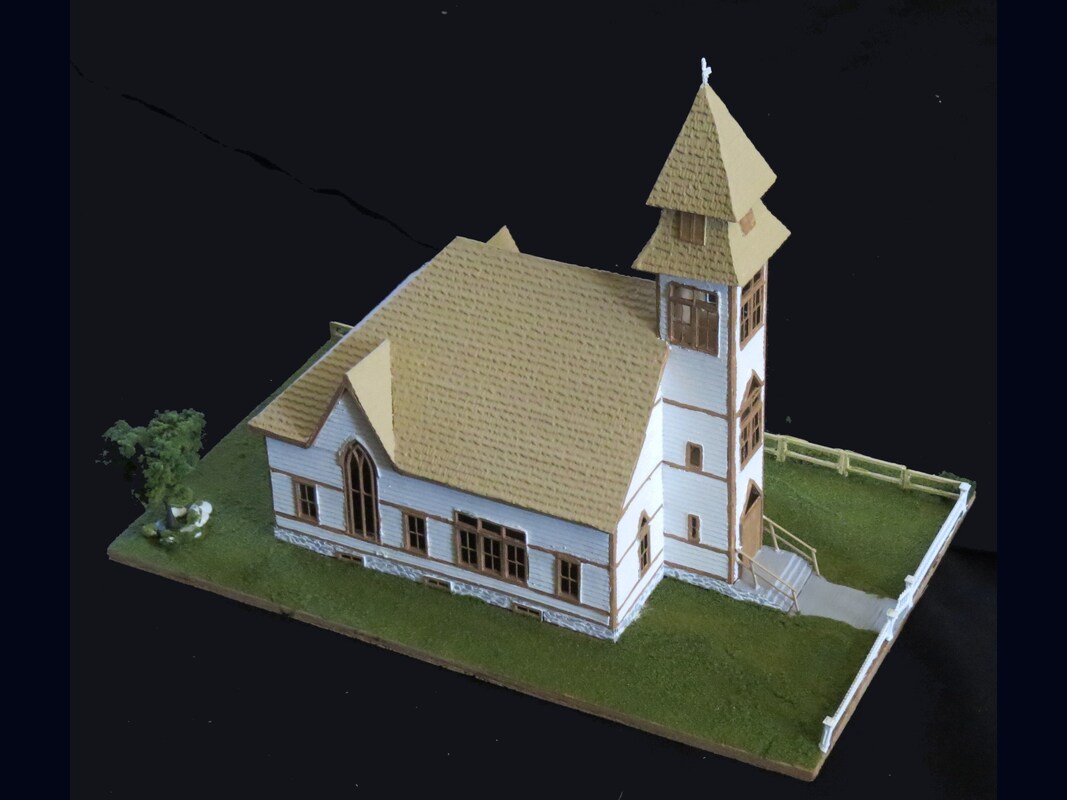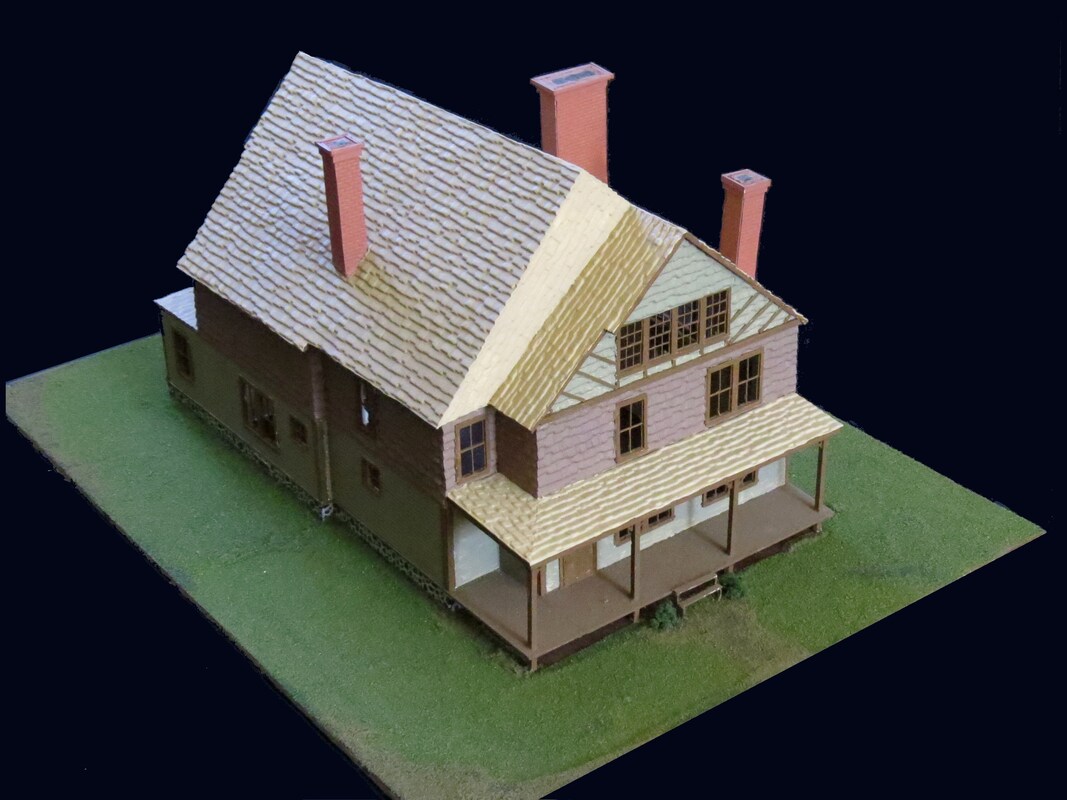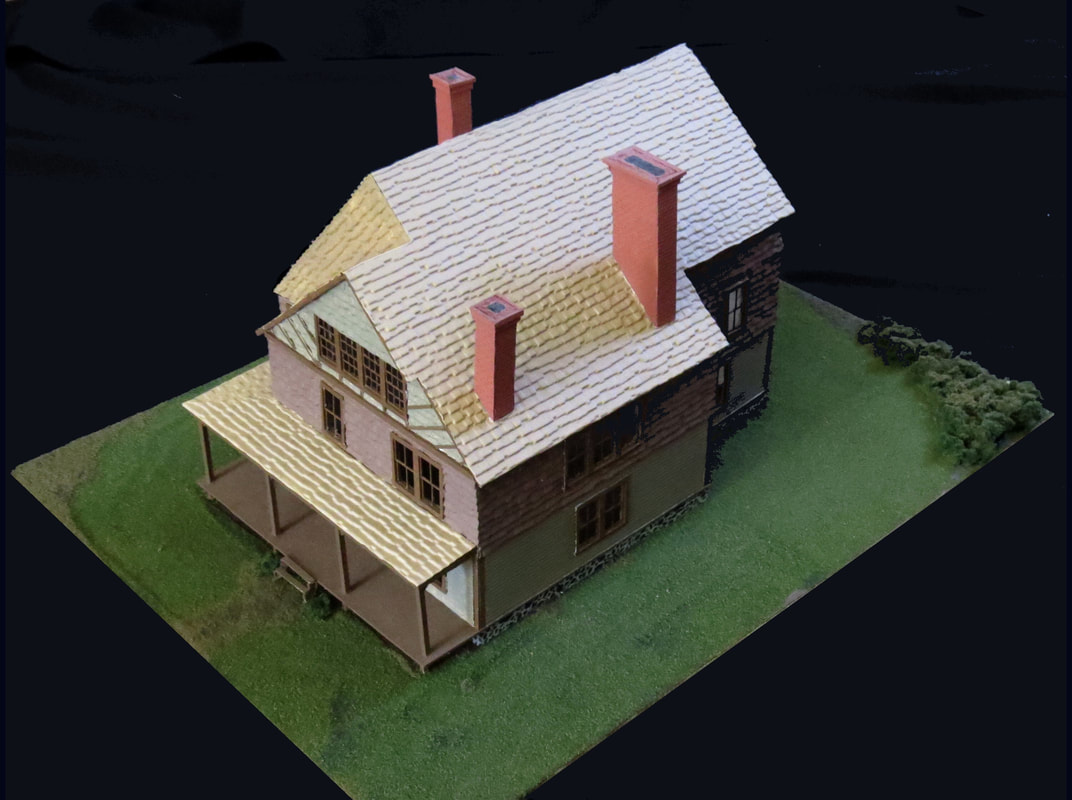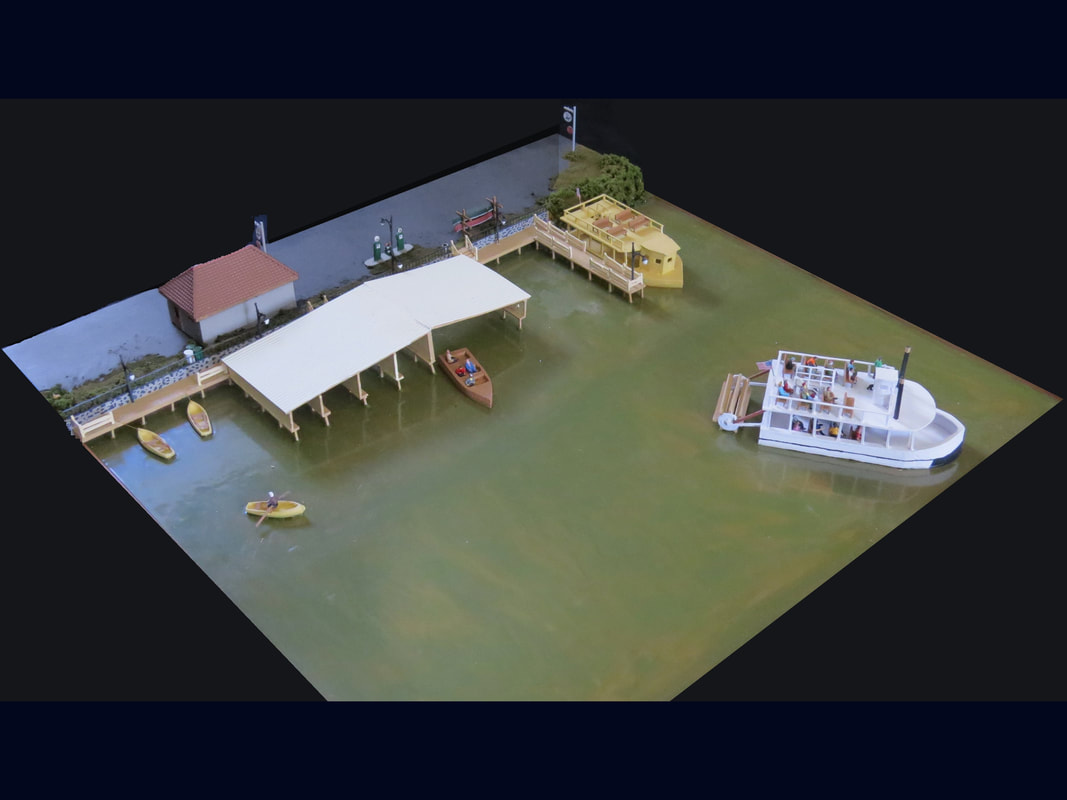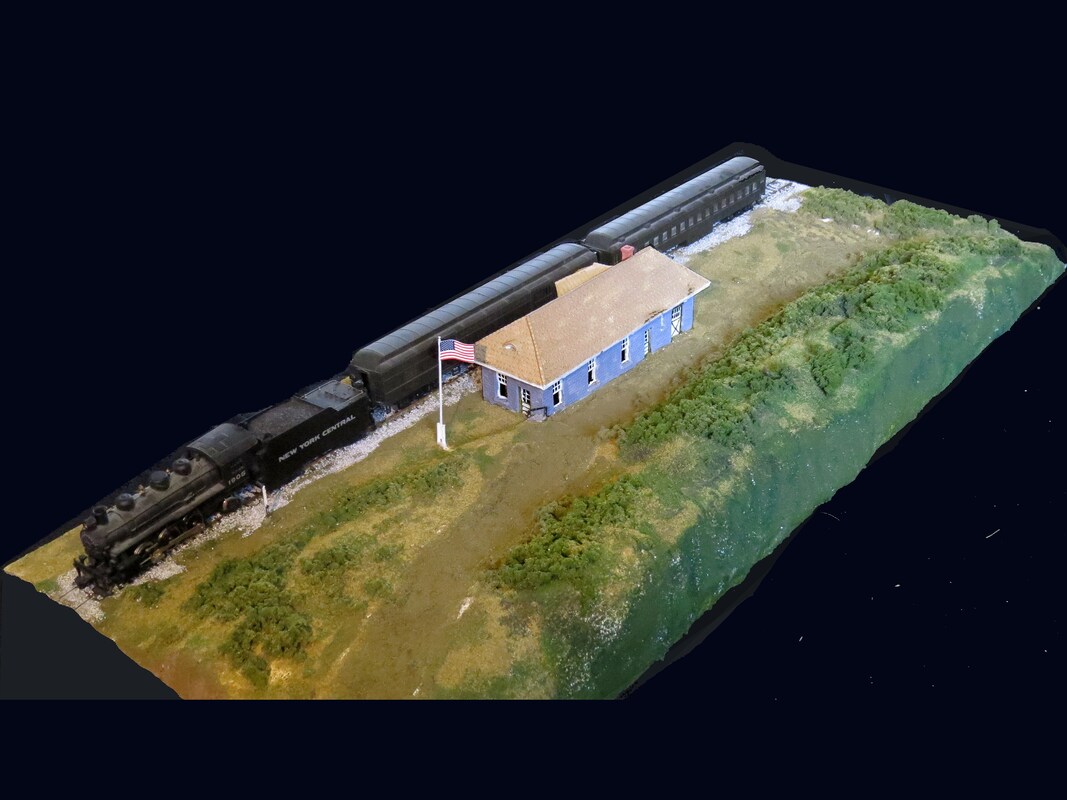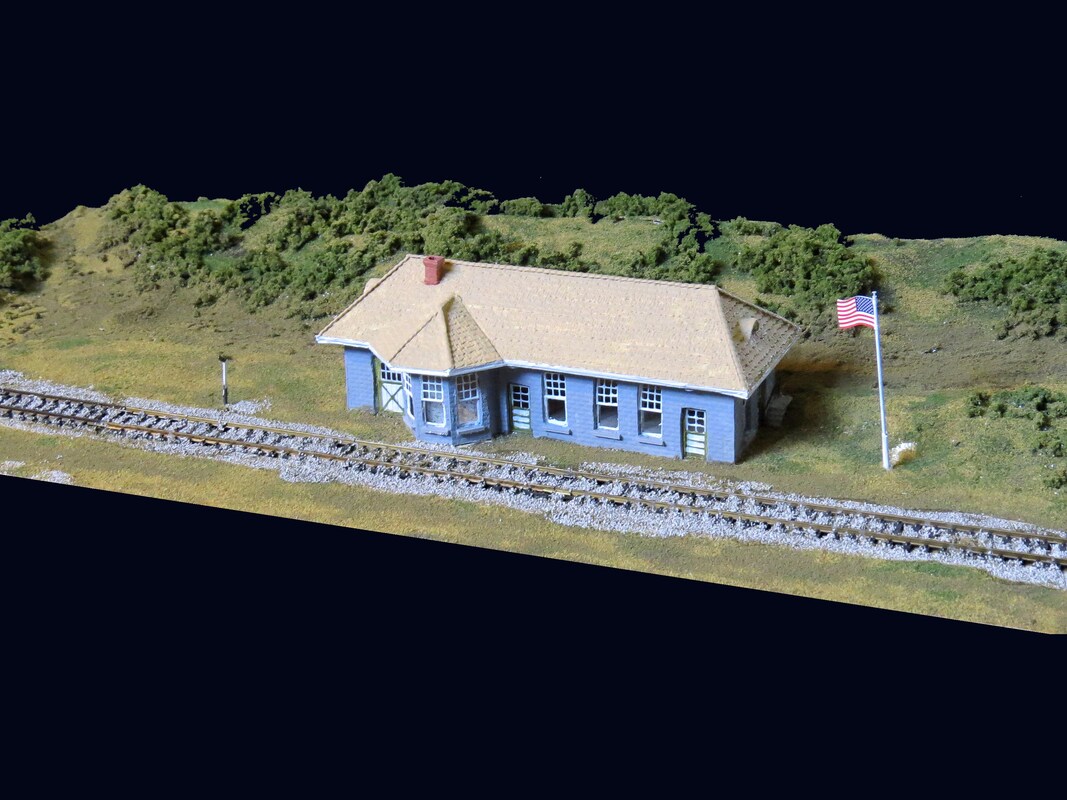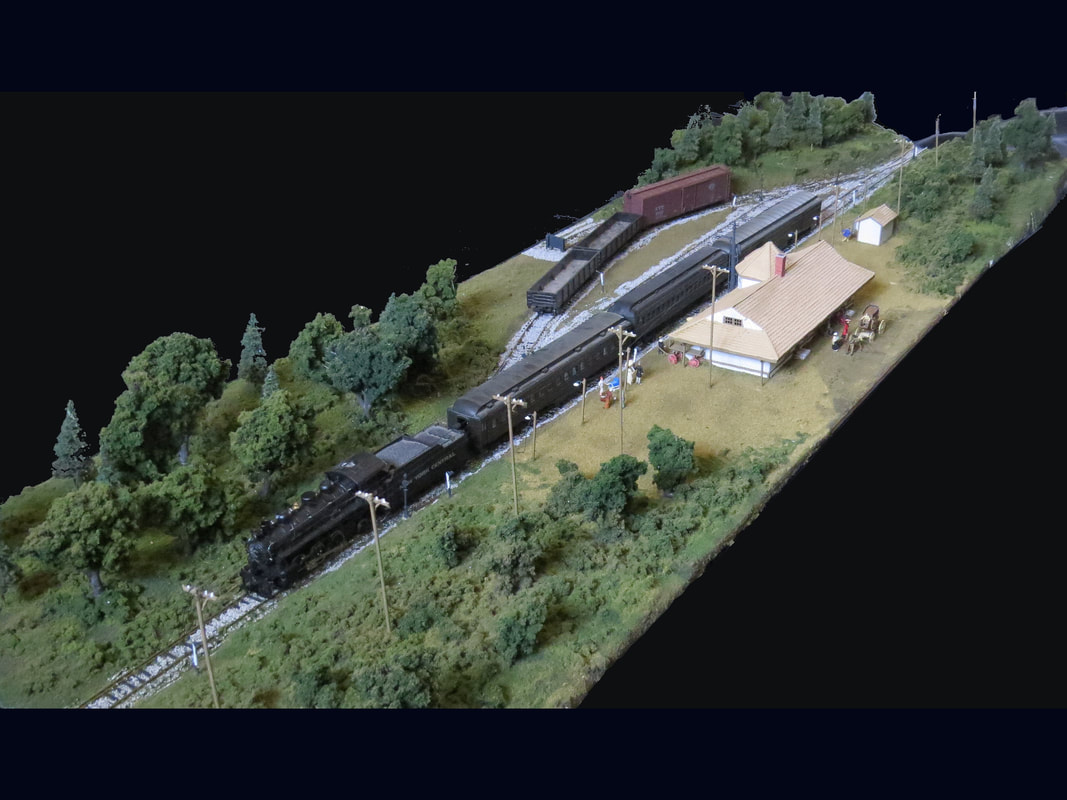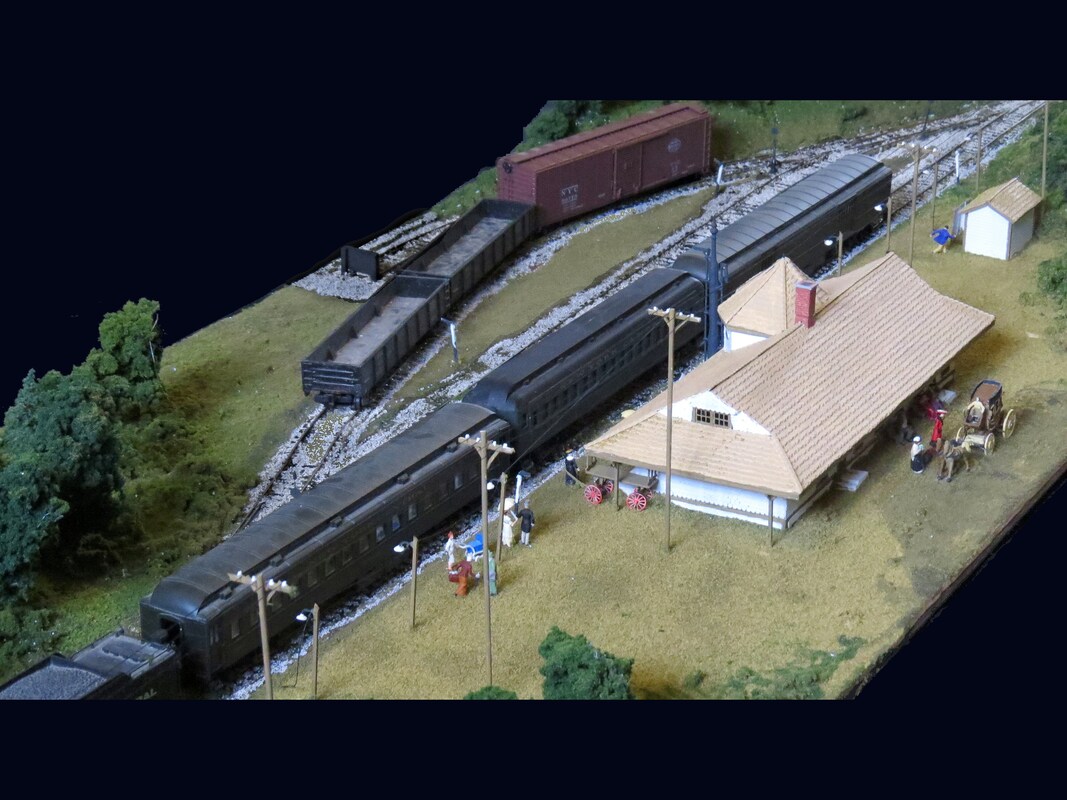MODELS OF LOST BUILDINGS OF SARANAC LAKE
by John Wheeler
Downing Block, Pontiac Theatre, and the Berkeley Hotel
|
DOWNING BLOCK
Location: 14 Broadway Built: 1896-99, 1908 Lost its third floor to fire c.1925. Originally known as Loomis' General Store, it was a major supplier of such items as packbaskets, traps, and hunting equipment. It was also the primary outlet for school supplies and the sole distributor of text books. A popular bar and restaurant, Downing and Cane's, opened in the building in the 1920s. Located adjacent to the Pontiac Theater, it was the place to go after the movies. |
PONTIAC THEATRE
Location: 13 Broadway (now a parking lot) Built: 1917 Burned 1978 The Pontiac Theatre at one time had the largest screen in central New York. Movies and stage shows played to a full house nightly. It had a twelve thousand dollar orchestral organ, and the marquee featured a painting of an Indian at the top of a triangle. Al Jolson once performed a benefit concert here. The world premiere of the 1954 film, The Silver Chalice was held at the theatre, hosted by television personality Art Linkletter. Saranac Lake won the movie premiere for having sold the most Christmas seals that year. It was Paul Newman's film debut. The Pontiac burned to the ground on December 19, 1978. |
BERKELEY HOTEL
Location: 88 Main Street (Berkeley Green) Built: 1875 ,expanded by 1893 Burned: 1981 Also known as Berkeley House, it was was built to accommodate tuberculosis patients who were then beginning to come to Saranac Lake. President Benjamin Harrison stayed here in 1890 when he came to dedicate the new Saranac Lake High School. The Berkeley suffered a fire on New Year’s Day in 1925. It housed a number of storefronts, and was home to the WNBZ radio station. The hotel burned to the ground in a dramatic winter fire in 1981. |
F.M. Bull's Drug Store, Seaver Miller Cottage, Empire Hotel
|
F. M. BULL’S DRUG STORE
Location: 18 Main Street, to the right of Little Italy Built: before 1895 Torn down: 1957 to build LaPan Highway Also known as: The Washer house, F.M. Bull's Drug Store featuring the village’s first telephone service, Barr’s Delicatessen, The Commercial Press, Toole Cottage, and it was an early site of radio station WNBZ. |
SEAVER MILLER COTTAGE
Location: 24 Main Street (to the left of today’s Town Hall) Built: 1856 Torn down: 1957 to build LaPan Highway. Milo B. Miller returned from the Civil War to open a general store in the basement of the Miller homestead at 24 Main St. At the time the building was torn down to build the highway, it was the oldest house in the village. |
EMPIRE HOTEL
Location: 28 Main Street, on the site of the old Town Hall Built: before 1895 Torn down: 1927 to build the new Harrietstown Town Hall Originally called the St. Nicholas Hotel, it was renamed the Dewey House, and then the Empire Hotel. There was an ice house and stable behind it. It had 29 rooms, and its dining room could seat 40. It was was nearly lost in the 1926 fire that consumed the town hall. The fire was discovered by members of the Saranac Club who were playing cards in the hotel at the time. |
The Riverside Inn
RIVERSIDE INN
Location: Riverside Park
Built: 1860
Torn down: 1930s
Originally named Blood's Hotel, when it opened on July 4th, Orlando Blood threw a ball for the occasion. The Riverside was known as “the gem of old Main Street, with 61 bedrooms, exclusive of those occupied by family and servants.” Mark Twain occasionally sat on the shaded veranda during his visit to the village at the turn of the century. The dining room could seat 130.
Location: Riverside Park
Built: 1860
Torn down: 1930s
Originally named Blood's Hotel, when it opened on July 4th, Orlando Blood threw a ball for the occasion. The Riverside was known as “the gem of old Main Street, with 61 bedrooms, exclusive of those occupied by family and servants.” Mark Twain occasionally sat on the shaded veranda during his visit to the village at the turn of the century. The dining room could seat 130.
Old Town Hall
OLD TOWN HALL
Location: 30 Main Street, site of the current town hall
Built: 1886
Lost to fire: 1926
The building provided classroom space for the high school, and hosted dances and troop mobilizations during WWI. It provided an auditorium for a local theater company and meeting space St. Bernard’s Church and the Odd Fellows Hall. The building stored the records of the Adirondack Daily Enterprise. It burned to the ground in a spectacular fire in July, 1926. Three prisoners in the village "lock-up" were badly burned.
Location: 30 Main Street, site of the current town hall
Built: 1886
Lost to fire: 1926
The building provided classroom space for the high school, and hosted dances and troop mobilizations during WWI. It provided an auditorium for a local theater company and meeting space St. Bernard’s Church and the Odd Fellows Hall. The building stored the records of the Adirondack Daily Enterprise. It burned to the ground in a spectacular fire in July, 1926. Three prisoners in the village "lock-up" were badly burned.
St. Bernard's Church
SAINT BERNARD’S CHURCH
Location: 21 St. Bernard Street
Built: 1894
Lost to fire: c.1908
The first St. Bernard's Roman Catholic Church was a beautiful wood-framed structure which opened in 1892. One source says that it burned in 1908, while another claims that the date was St. Patrick's Day in 1909. A second St. Bernard's Church was built in 1911. An impressive stone structure, it seated 800 people. The steeple was 91 feet high. It burned in 1967.
Location: 21 St. Bernard Street
Built: 1894
Lost to fire: c.1908
The first St. Bernard's Roman Catholic Church was a beautiful wood-framed structure which opened in 1892. One source says that it burned in 1908, while another claims that the date was St. Patrick's Day in 1909. A second St. Bernard's Church was built in 1911. An impressive stone structure, it seated 800 people. The steeple was 91 feet high. It burned in 1967.
Dr. E. L. Trudeau's First House
DR. TRUDEAU'S FIRST HOUSE
Location: 5 Church St. / 105 Main St.
Built: 1884
Lost to fire: 1894
Dr. E. L. Trudeau built this home in the village and set up shop as the first physician in town. Soon he added a small laboratory to the house in order to conduct experiments on the tuberculosis bacillus. In 1893 the house and laboratory burned to the ground. A second home was built in its place, and three generations of Trudeau doctors practiced there.
Location: 5 Church St. / 105 Main St.
Built: 1884
Lost to fire: 1894
Dr. E. L. Trudeau built this home in the village and set up shop as the first physician in town. Soon he added a small laboratory to the house in order to conduct experiments on the tuberculosis bacillus. In 1893 the house and laboratory burned to the ground. A second home was built in its place, and three generations of Trudeau doctors practiced there.
A. Fortune & Co., A&P, Munn's Business Machines, Colonial Theatre, The One Minute Lunch, United Shoe Repair, Pedroni's Jewelry,
|
A. FORTUNE & COMPANY
Location: 65 Broadway Built: 1892 Demolished between 1969 and 1970 Built by Antoine Fortune, this was a furniture and decorating supply store that became a funeral home. The Fortune-Keough Funeral Home on Church Street is still in business. The funeral business evolved from the fact that the firm's cabinet makers were called upon to make caskets. |
A&P
Location: 61 Broadway Now the location of the Adirondack Daily Enterprise This building hosted the A&P from 19350 through 1965. Also known as: Carlin’s Home Bakery, Sears and Roebuck catalog sales office, Burger Family, Coach and Four, the Adirondack Daily Enterprise. |
MUNN’S BUSINESS MACHINES
Location: 57 BroadwayAlso known as Wade Cottage (1930), Mrs. Signor House (1931) |
COLONIAL THEATRE
Location: 55 Broadway Torn down: 1974 Now the location of Community Bank The Colonial Theatre had a seating capacity of 500 on the main floor and balcony. The third floor was leased for five years to the Lodge of Odd Fellows. This theatre was nicknamed “the Itch.” In the 1920s, the building was renovated to become Mullen’s Grocery and eight upstairs apartments. In the 1930s it housed TB patients. |
THE ONE MINUTE LUNCH
Location: 51 Broadway Now parking lot for Community Bank This was one of the most popular diners in Saranac Lake in the 1940s. The City Restaurant was the name for the attached dining room. Popularly, it was known as "Dickie's" for Lief Dickie, who owned and operated the restaurant, as his father did before him. That was a regular hangout after the movies. A hamburger and a coffee cost 25 cents. Downing's Delicatessen & Quick Lunch appears in a c. 1910 photograph at the same location. UNITED SHOE REPAIR Location: 49 Broadway Now parking lot for Community Bank PEDRONI’S JEWELRY Location: 47 Broadway Now parking lot for Community Bank Also known as the Keet Building, Bosworths, Henry Pedroni Jeweller, McCrea’s Radio & Television, and the office of Dr. Richard Erenstone |
Thomas Boat Landing
THOMAS BOAT LANDING
Location: 35 River Street, on the north shore of Lake Flower
The Thomas Boat Landing was a boat rental and cruise boat business. Two boats, the Adirondack and the Pollyanna, ran the Lower Saranac route. Both double-decker boats could carry 150-175 passengers. Among the famous passengers who rode on the Thomas boats was entertainer Al Jolson.
Location: 35 River Street, on the north shore of Lake Flower
The Thomas Boat Landing was a boat rental and cruise boat business. Two boats, the Adirondack and the Pollyanna, ran the Lower Saranac route. Both double-decker boats could carry 150-175 passengers. Among the famous passengers who rode on the Thomas boats was entertainer Al Jolson.
Ray Brook Station
RAY BROOK STATION
Year built: 1907, rebuilt 1930
The Ray Brook Station on the Saranac Lake and Lake Placid Railroad served Delaware and Hudson trains from August 1, 1893 until November 1, 1946, and New York Central passenger trains from 1893 until April 25, 1965. A special siding was added in 1932 to handle extra trains for the 1932 Winter Olympics. In 1913 the Ray Brook Post Office moved to the New York Central train station. On December 9, 1928, the Post Office and Queen Anne train station burned to the ground, destroying a large number of Christmas parcels, as well as all the letter mail in the P.O. boxes and General Delivery desk in the Post Office. The new "stone" (or concrete block) Delaware and Hudson Passenger Station at Ray Brook was built in 1930 by J. J. Fitzpatrick and Sons of Plattsburgh, and the P.O. returned there. After a long decline, the New York Central passenger service on its Adirondack Division ended April 24, 1965, the last branch line service on the New York Central System. Until the very end, the line was operated in the fine old tradition of railroading, using Morse telegraphy, train orders and manual block station. The P.O. remained in the train station until 1975, when the building was quite run down. That year the P.O. was moved back to a trailer on the former Ray Brook hospital grounds, by that time converted to Camp Adirondack Minimum Security Correctional Facility.
Year built: 1907, rebuilt 1930
The Ray Brook Station on the Saranac Lake and Lake Placid Railroad served Delaware and Hudson trains from August 1, 1893 until November 1, 1946, and New York Central passenger trains from 1893 until April 25, 1965. A special siding was added in 1932 to handle extra trains for the 1932 Winter Olympics. In 1913 the Ray Brook Post Office moved to the New York Central train station. On December 9, 1928, the Post Office and Queen Anne train station burned to the ground, destroying a large number of Christmas parcels, as well as all the letter mail in the P.O. boxes and General Delivery desk in the Post Office. The new "stone" (or concrete block) Delaware and Hudson Passenger Station at Ray Brook was built in 1930 by J. J. Fitzpatrick and Sons of Plattsburgh, and the P.O. returned there. After a long decline, the New York Central passenger service on its Adirondack Division ended April 24, 1965, the last branch line service on the New York Central System. Until the very end, the line was operated in the fine old tradition of railroading, using Morse telegraphy, train orders and manual block station. The P.O. remained in the train station until 1975, when the building was quite run down. That year the P.O. was moved back to a trailer on the former Ray Brook hospital grounds, by that time converted to Camp Adirondack Minimum Security Correctional Facility.
Saranac Inn Station
SARANAC INN STATION
Saranac Inn Station was the site of the railroad station serving Saranac Inn. It was located at the end of Station Road, a fifty-yard long spur off of Fish Hatchery Road, which itself is a loop off of New York Route 30 that starts opposite the western end of Forest Home Road. Fish Hatchery Road follows the former roadway of Route 30; the Adirondack Fish Hatchery is still in operation. It was also the site of the Saranac Inn Nursery and the Experiment Station Nursery. The station was built in 1892, replacing the Derrick station, built in 1890 nine miles to the west. It originally served the New York and Ottawa Railway. It closed in 1956 or '57.
Saranac Inn Station was the site of the railroad station serving Saranac Inn. It was located at the end of Station Road, a fifty-yard long spur off of Fish Hatchery Road, which itself is a loop off of New York Route 30 that starts opposite the western end of Forest Home Road. Fish Hatchery Road follows the former roadway of Route 30; the Adirondack Fish Hatchery is still in operation. It was also the site of the Saranac Inn Nursery and the Experiment Station Nursery. The station was built in 1892, replacing the Derrick station, built in 1890 nine miles to the west. It originally served the New York and Ottawa Railway. It closed in 1956 or '57.
